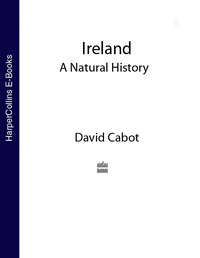
Полная версия
Collins New Naturalist Library
One of the curious features of alpine plants in Ireland is that many of them do not remain perched high up on the mountains but descend down to sea level and into the countryside, sometimes well away from their alma mater. In fact, even when on the mountains they prefer reasonable to dizzy heights. Praeger looked at their distribution in relation to elevation in Ireland and found that the number of species increased steadily as one travelled towards the summit with a maximum number of 19 species at 300 m above sea level. Thereafter their numbers decreased equally steadily.9 Praeger also noted that 16 of the 42 so-called Watsonian ‘highland’ plants (including arctic-alpines and alpines) occur down to sea level. In fact, most Irish summits have a paltry flora, generally almost devoid of alpines and arctic-alpines. These are happier growing at lower levels, in more favourable habitats where, for instance, there are outcrops of mineral-rich rocks, and the ground is free from tall vegetation.
A few of the alpines do not give in to this ‘erratic’ behaviour but, as Hart observed, they are not numerous: ‘Of those more thoroughly alpine plants which never descended to sea level in these mountains (or elsewhere in Ireland), only three are ever met with on the exposed summits or outer ridges.’8 They were alpine clubmoss, dwarf willow and stiff sedge. As to the species that will occur very high up, Praeger listed eight that persisted above 914 m on the Macgillycuddy’s Reeks, Co. Kerry.3 The species, with their maximum recorded altitudes in Ireland were: starry saxifrage (1,036 m), alpine hair-grass (1,027 m), stiff sedge (1,006 m), green spleenwort (960 m), mountain sorrel (960 m), roseroot (960 m), alpine meadow-grass (945 m) and dwarf willow (930 m). These, together with the alpine clubmoss, could be taken as the hard core of the Irish alpine and arctic-alpine flora.
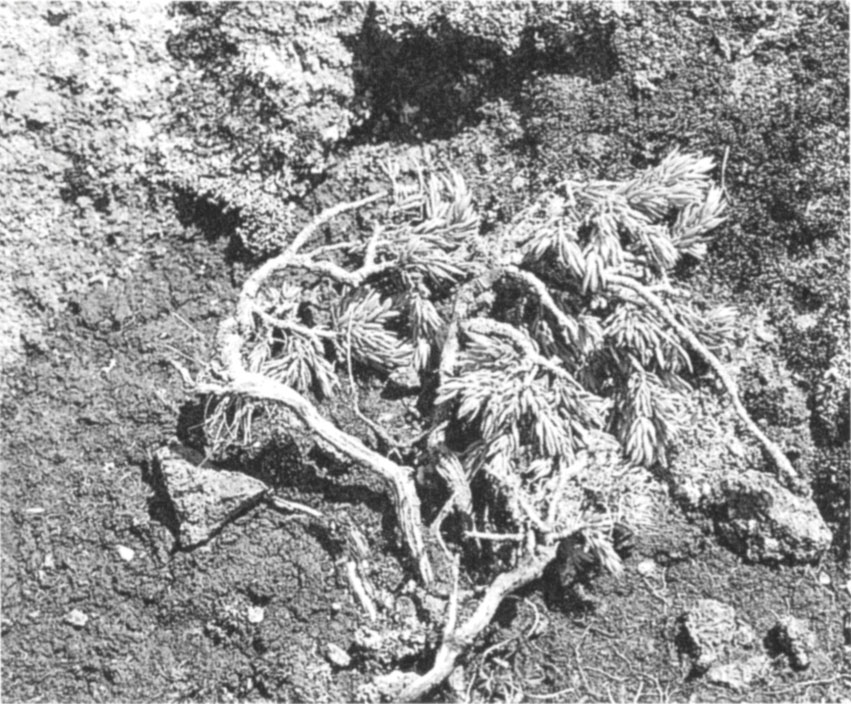
Juniper is common on some mountains, where the subspecies Juniperus communis subsp. nana is mainly found on siliceous rocks, always growing prostrate.
Most Irish summits – generally covered by thin peat or just bare soil and stones – make drab spots for flowers, whether or not of the alpine kind. One wishing to find ‘summit’ flowers might well have to abseil down along the north-facing cliffs and scarps in order to peruse the nooks and crannies and the rock overhangs. Praeger – himself a fearless cliffhanger – listed 13 of these core ‘summit’ plants, based on an analysis of the flora of the seven highest Irish peaks. They were tormentil, heath bedstraw, bilberry, heather, sheep’s sorrel, crowberry, heath rush, great wood-rush, hare’s-tail cottongrass, tufted hairgrass, sweet vernal-grass, sheep’s fescue and fir clubmoss.
Four maritime plants, which could be considered ‘sea-loving’, are frequently encountered growing on mountains at high altitudes in the company of alpine species. The first, thrift, a common coastal species, occurs on most of the highest mountains in Ireland. Hart encountered it at or close to the summits of the Mayo and Galway mountains – on Nephin and Mweelrea, Co. Mayo, both at 805 m, Croagh Patrick, Co. Mayo, at 675 m, and in the Twelve Bens, Co. Galway, up to 686 m. At Corraun, Achill Island, Co. Mayo, thrift grows abundantly on siliceous rocks at sea level, but then appears only above 366 m. It also grows at the summit of Carrauntoohil, Co. Kerry, at 1,039 m. Thrift adopts different shapes according to environmental stress. In its mountain habitat, subjected to grazing or particularly dry conditions it contracts into a dense cushion with short leaves and stems. Without stress, especially flourishing at sea level, it takes on a more straggly, less defensive aspect.
The sea plantain grows on the highest Galway and Mayo mountains up to 792 m. A curiously stunted variety, with broad leaves and a stem 3.8 cm high, was found by Hart at 701 m on the Askaheeraun ridge, Mweelrea, and on the summit of Ben Creggan (693 m), Co. Mayo. In the Twelve Bens the species ascends to 518 m. On Achill Island, Co. Mayo, it occurs continuously from the summit of Slievemore (671 m) to the sea-drenched cliffs below. This plantain also grows inland at low altitude levels, breaking with convention when it occurs around the shores of Lough Derg – some 40 km from the coast. It is also on the limestone pavements around Loughs Corrib, Mask, Carra, and Conn, Co. Mayo.
There are also outposts of maritime plants, including the two already mentioned and the following species, at the Killarney lakes, Co. Kerry, and around the shore of Lough Neagh in Northern Ireland. The white-flowered sea campion, normally found growing on sea cliffs, islands and coastal shingle, occurs on most of the Galway and Mayo mountains – on Croagh Patrick at 764 m, Mweelrea and Benlettery, Connemara, at 580 m and Birreencorragh, Co. Mayo, at 610 m. The common scurvygrass, common in dry salt marshes and coastal areas is also found in its subspecific form Cochlearia officinalis subsp. alpina in the Galty Mountains, Co. Tipperary, as well as joining the other three species already mentioned on the Binevenagh cliffs, Co. Derry. Finally, Hart also mentions a fifth species, the English stonecrop, as a member of the group which displays such aberrant distribution. A plant of rocky places, very frequently near the sea and rarely inland, this stonecrop is found on the Cork and Kerry mountains up to 801 m while in Wicklow it occurs up to 594 m and in Donegal up to 259 m.
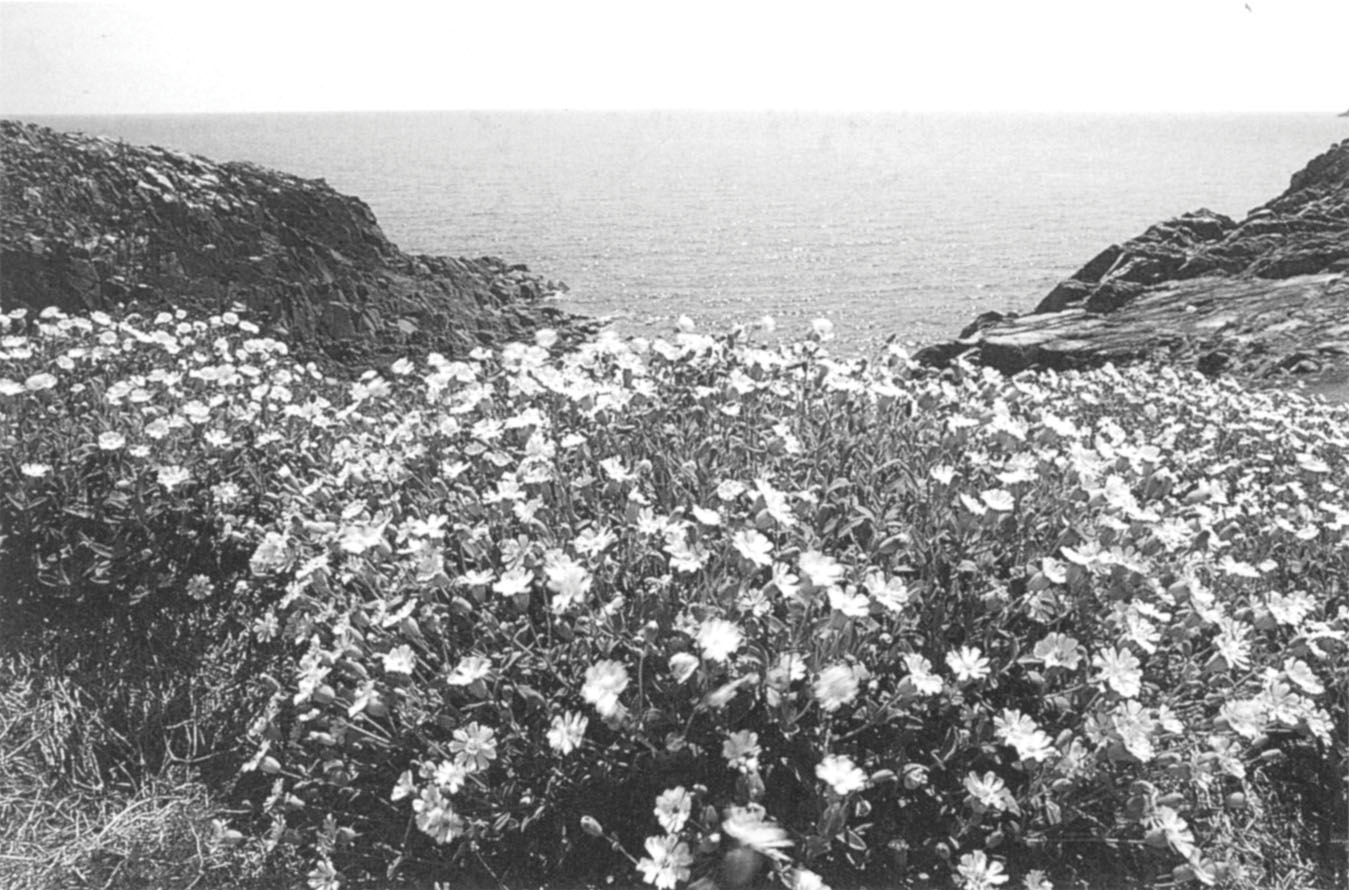
Sea campion in its more natural lowland and coastal habitat, Little Saltee Island, Co. Wexford.
A plausible explanation for the mountain ascent of these maritime plants was put forward over 100 years ago by the Scottish naturalist Buchanan White who argued that they were part of the late glacial flora that was forced to migrate ahead of the expanding woodland cover during the Atlantic period. As the upper parts of the mountains were generally the only tree-free areas this is where the plants retreated to and survived until today.10 Work carried out by Watts on the flora of the Quaternary period in Ireland has shown that several species – likely candidates for migration up the mountain slopes – could be identified from the interglacial deposits at Kilbeg, Co. Waterford.11 The records included alpine meadow-rue (fruits), alpine clubmoss (spores), juniper (pollen, seed, needle), lesser clubmoss (micro and megaspores) and the sea plantain (pollen). Once established on mountain tops these, and many other species, found themselves safe from the re-advancing glaciers when another cold spell clamped down on the Irish landscape.
Principal locations for alpine and arctic-alpine species
The Wicklow Mountains and uplands
The Wicklow Mountains and uplands are the most extensive area of granite in Ireland and greater than any in Britain. The region is of considerable natural beauty and topographical diversity, where glacier-scoured river valleys and glens clothed in broadleaved woods host enchanting lakes; where large tracts of blanket bog are presided over by granite summits and dominated by Lugnaquillia Mountain (925 m); where there is a swaddling coverage of coniferous plantations, and where cliffs and corries are frequent. The vegetation found there is characteristic of the upland and mountain habitats of many other sections of Ireland.
During the winter of 1901–2 George H. Pethybridge, a young English plant physiologist, teamed up with Praeger to start a survey of the vegetation lying south of Dublin, including the Wicklow uplands.12 According to White this was the start of the modern investigations of Irish vegetation.13 Pethybridge & Praeger distinguished four zones: (i) the lowest, or the littoral zone which is of little or no interest to botanists; (ii) farmland, that merged into (iii) hill pasture at about 275 m (with gorse to begin with and western gorse at higher altitudes) before giving way to (iv) heather moorland which developed at around 380 m and continued upwards to the highest – flora-poor – summits.
The dry heath of the hill pasture, dominated by western gorse, heather and bell heather, is typically found in Counties Dublin and Wicklow from about 70 m to 400 m. The dry heath community was not described in detail and had to wait for its first precise description by Clark in 1968.14 Where the heath had been burnt about four years previously, Clark found that western gorse formed a mat of vegetation 20–30 cm tall. In areas untouched by fire for more than ten years the gorse was taller – 30–50 cm – and often more open, leaving room for bell heather, heather and a sparse herb layer of mainly sheep’s fescue and some common bent.
Western gorse, abundant in eastern Ireland and more local in the west, is characteristically found in coastal, lowland and sub-montane habitats, especially in the Wicklow Mountains where it occurs typically in the upper hill pasture areas before the vegetation changes to heather moorland at about 400 m. The somewhat similar but much taller gorse (also known as furze or whin) occurs typically at lower altitudes in the Wicklow hills and elsewhere in Ireland.
Higher up in the heather moorland Pethybridge & Praeger described areas, especially on the flat summits, dominated by deergrass and common cotton-grass. On the flat summit of Lugnaquillia Mountain they found a thin skin of vegetation, dominated by the woolly fringe-moss, bilberry, heath bedstraw, heath rush, stiff sedge, the moss Polytrichum commune and colonies of the alpine clubmoss.
The Wicklow uplands are a disappointment for mountain plants when compared with some of the highland sites in the northern and western counties. Both the arctic-alpine roseroot and the mossy saxifrage, first reported in 1897 and 1927 respectively, have not been found recently and are feared to be extinct.15 St Patrick’s cabbage and fir clubmoss are found on the mountain itself. The occurrence of St Patrick’s cabbage is an oddity because Lugnaquillia Mountain is very much an outlying station, far away from the main centre of distribution in Cork and Kerry. Some 13.5 km northeast of Lugnaquillia Mountain a rocky escarpment at 557 m overlooking Lough Ouler, near Tonelagee, hosts alpine lady’s-mantle and, together with a site on the Brandon Mountains, Co. Kerry, these are the only localities where the species has been seen in Ireland since 1970. Alpine lady’s-mantle is tall for an arctic-alpine, reaching up to 20 cm. Its leaves, unlike those of its close relative lady’s-mantle, are divided to the base and underneath are silvery grey with hairs. The flowers are small (3 mm) and pale green. Also growing on the Lough Ouler escarpment is alpine saw-wort which belongs to the daisy family. It is a short, stout perennial that looks somewhat like a thistle with fragrant purple flowers in August-September. Both alpine lady’s-mantle and alpine saw-wort were first recorded in Ireland from the mountains of ‘Keri’ by the Welsh antiquarian and naturalist Edward Lhwyd in 1699. Alpine saw-wort has now been reported from 26 sites in Ireland, at altitudes over 300 m. It is thought to be declining.16
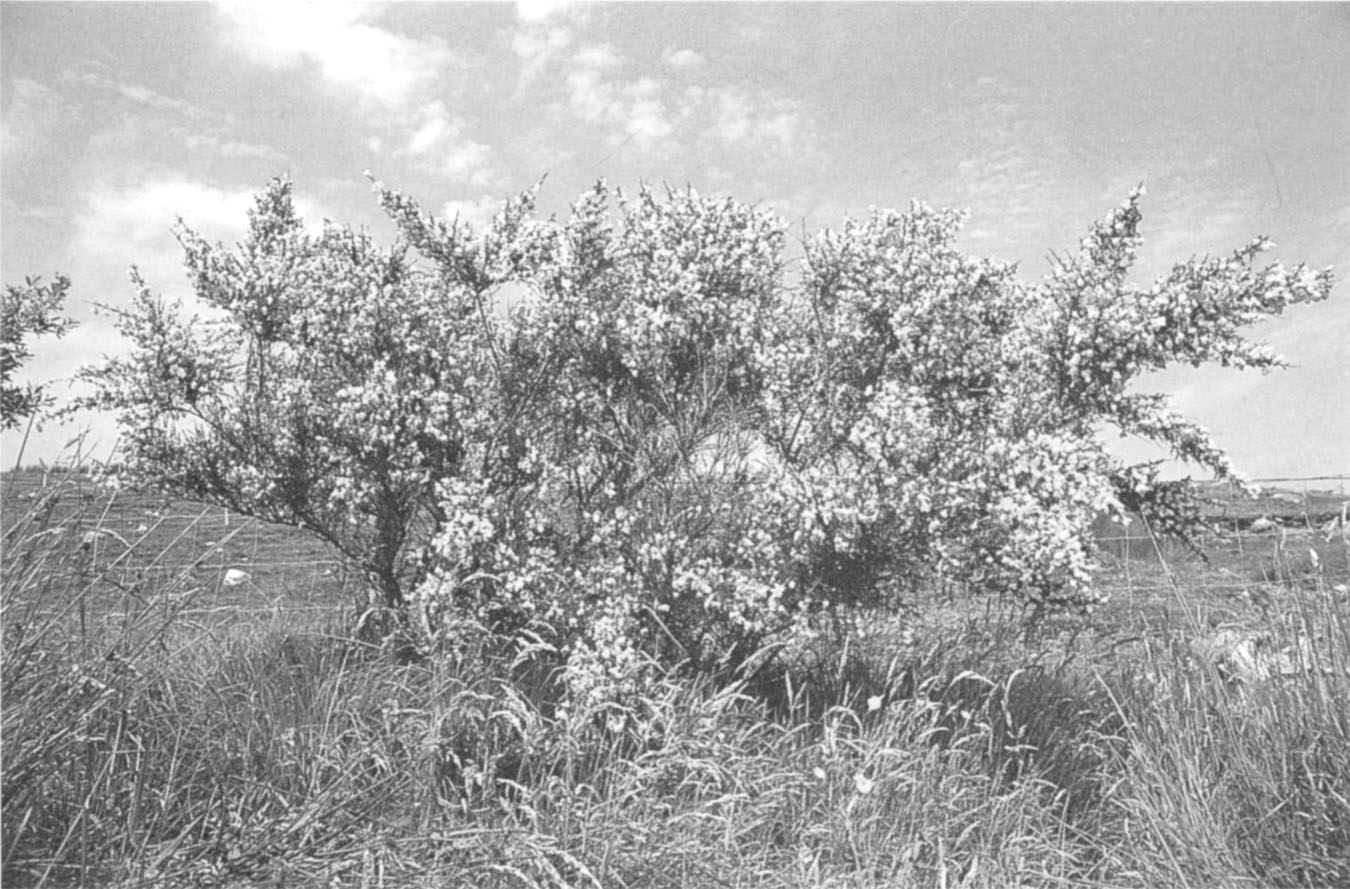
Gorse, furze or whin, characteristic of the rough grassland or heaths of the lower parts of the Wicklow Mountains.
A re-survey of the area studied by Pethybridge & Praeger was carried out 50 years later by John J. Moore, champion in Ireland of the study of plant communities using the mathematical and quantitative phytosociological methods of the German botanist Braun-Blanquet.17 Moore redefined the plant communities and found that they had remained remarkably stable over the years, the main changes being an advance of bracken, extending its range by a maximum distance of 150 m, and to a lesser extent of western gorse, into abandoned farmland. A widespread reduction in the frequency of the woolly fringe-moss in the high land was also observed.
The Galway and Mayo highlands
The great metamorphic rock masses of west Galway and Mayo stretch some 120 km from south Connemara to north Erris in one of the wildest and most beautiful parts of Ireland. In the south, the Twelve Bens stand out as rugged steep-sided mountains with quartzite peaks, many of which are higher than 600 m. Although the region is described as the Twelve Bens, there are, as pointed out by Hart, 17 more or less detached peaks from about 457–731 m.8 Mica schists appear in the western peaks and through weathering break down to provide the more attractive calcareous soils on which many mountain species thrive in an abundance rarely attained elsewhere in Ireland. To the east of Lough Inagh, defining the eastern boundary of the Twelve Bens, lie the Maumturk Mountains, a large ridge of quartzite, peaking at 702 m. Blanket bogland, characterised by purple moor-grass which grows with extreme luxuriance, dominates the Connemara slopes to about 300 m before giving way to vegetation in which heather is the key species.
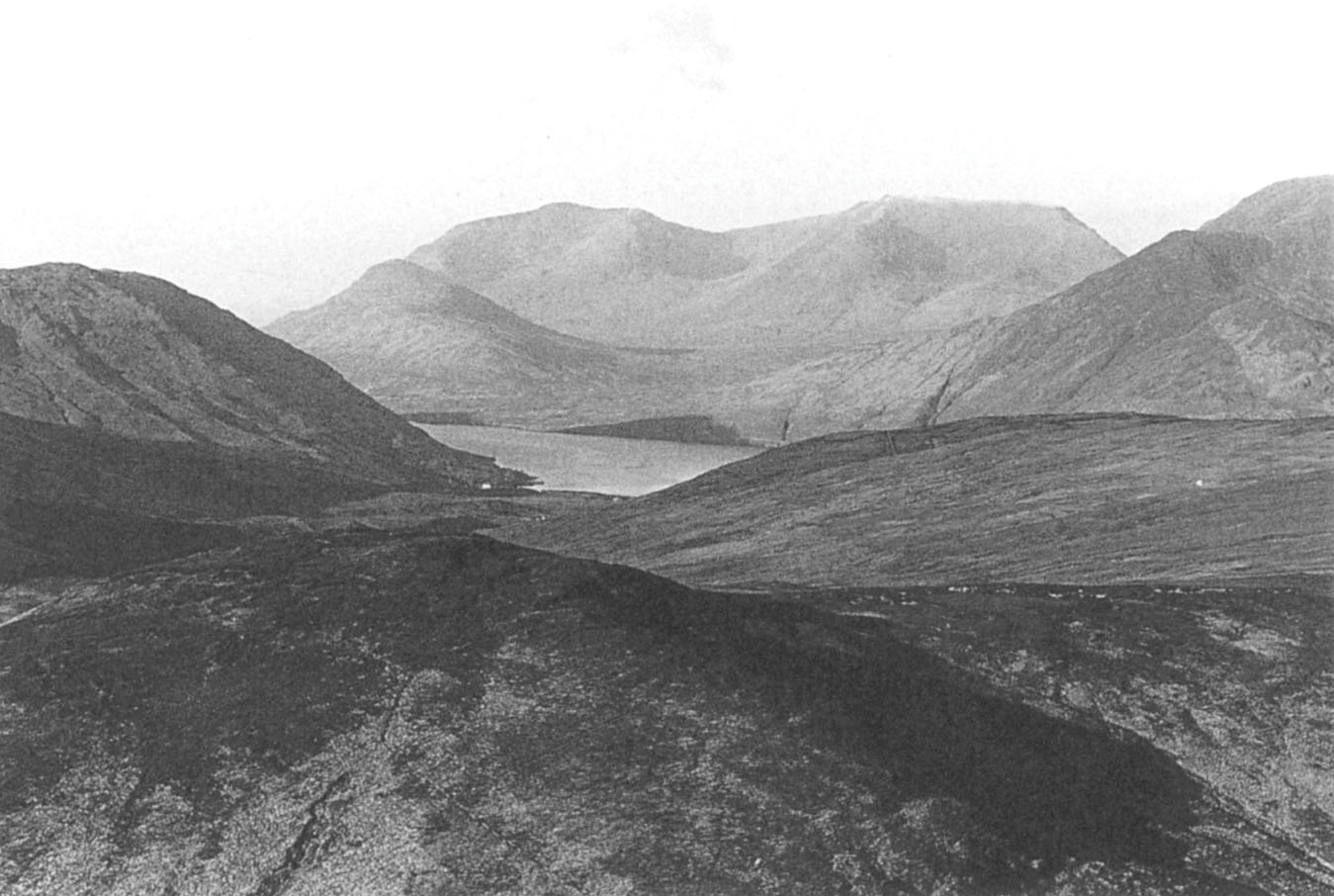
Irish mountains and uplands are invariably bleak, generally bereft of woody vegetation above 300 m. Here, in the neighbourhood of the Killary Harbour, Co. Mayo, the siliceous soils, derived from Silurian slates and shales, offer little opportunity for a diverse vegetation.
Bengower is one of the most southerly peaks of the Twelve Bens and its summit reaches 666 m. The vegetation of the north-facing slope at 550 m was examined in the early 1960s by Ratcliffe, the first to give a detailed description of the flora of that particular stretch.18 No remarkable specimens were found apart from the liverwort Adelanthus lindenbergianus, a southern hemisphere species first discovered at Slievemore, Achill Island, Co. Mayo, in 1903 by H. W. Lett – when it was mistakenly named as an endemic, A. dugortiensis – and only known from these two stations and from Errigal and Muckish Mountains, Co. Donegal.
Praeger wrote that the best ground for the botanist is Muckanaght (654 m) in the centre of the Twelve Bens, where ‘an oasis of schist in a Sahara of quartz’ encourages a ‘very pretty colony of alpine plants’.3 Alpine meadow-rue, purple saxifrage, mountain sorrel, alpine saw-wort, dwarf willow and holly fern grow here. Ever since Wade first published a list, albeit slender, of the flora of Connemara – in which he recorded the first discovery in Ireland of the American species pipewort19 – Connemara has attracted a continuous procession of distinguished botanists and naturalists. The most extensive botanical investigations of the Connemara mountains were carried out by Hart, whose 1883 paper remains a standard text today.8 Colgan followed soon afterwards with a less ambitious work2 and Praeger was also a frequent visitor from the early part of this century.3 More recent investigations on mountain plants have been published by Roden20, while Webb & Scannell provide an account of all Connemara plants in Flora of Connemara and the Burren.21

Slievemore, Achill Island, Co. Mayo, in the distance.
Mweelrea Mountain, Co. Mayo
The Irish name of this highest mountain in Connacht – An maol riabhach: ‘the grey bald mountain top’ – fits it perfectly. Built of Silurian slates and shales chiefly with sandstones, schists and conglomerates, it presides boldly over a remote corner of southwestern Mayo, overlooking Killary Harbour. To the north are the islands of Clare and Achill; to the east the more stark grey mountain of Ben Gorm (700 m) and the Sheeffry Hills (highest point 762 m). Whilst in many respects a smooth and accessible mountain, Mweelrea has high vertical cliffs on the inland side. As observed by Hart when he visited the summit (814 m) in the summer of 1882, the prospects for alpine plants are raised but not completely fulfilled by ‘the long ranges of precipices, ridges and gullies ending in ravines with sheer sides and dangerous nooks’. Once he got to the top he found the following, amongst other species: St Patrick’s cabbage, starry saxifrage, roseroot, the hawkweeds Hieracium anglicum and H. iricum, bearberry, mountain sorrel, dwarf willow, stiff sedge, tufted hair-grass, alpine clubmoss, lesser clubmoss and quillwort.
During a visit in September 1961, while examining the cliffs at the head of the great north corrie at nearly 790 m on the east spur of Mweelrea, Ratcliffe discovered the liverwort Jamesoniella carringtonii, widespread in the Scottish Highlands but never previously recorded in Ireland. On Mweelrea it was found growing sparingly on broken cliffs and ledges amongst tufts of other liverworts – Herbertus aduncus subsp. hutchinsiae, Pleurozia purpurea, Bazzania pearsonii, B. tricrenata, Scapania ornithopodioides, S. gracilis and Plagiochila spinulosa.18
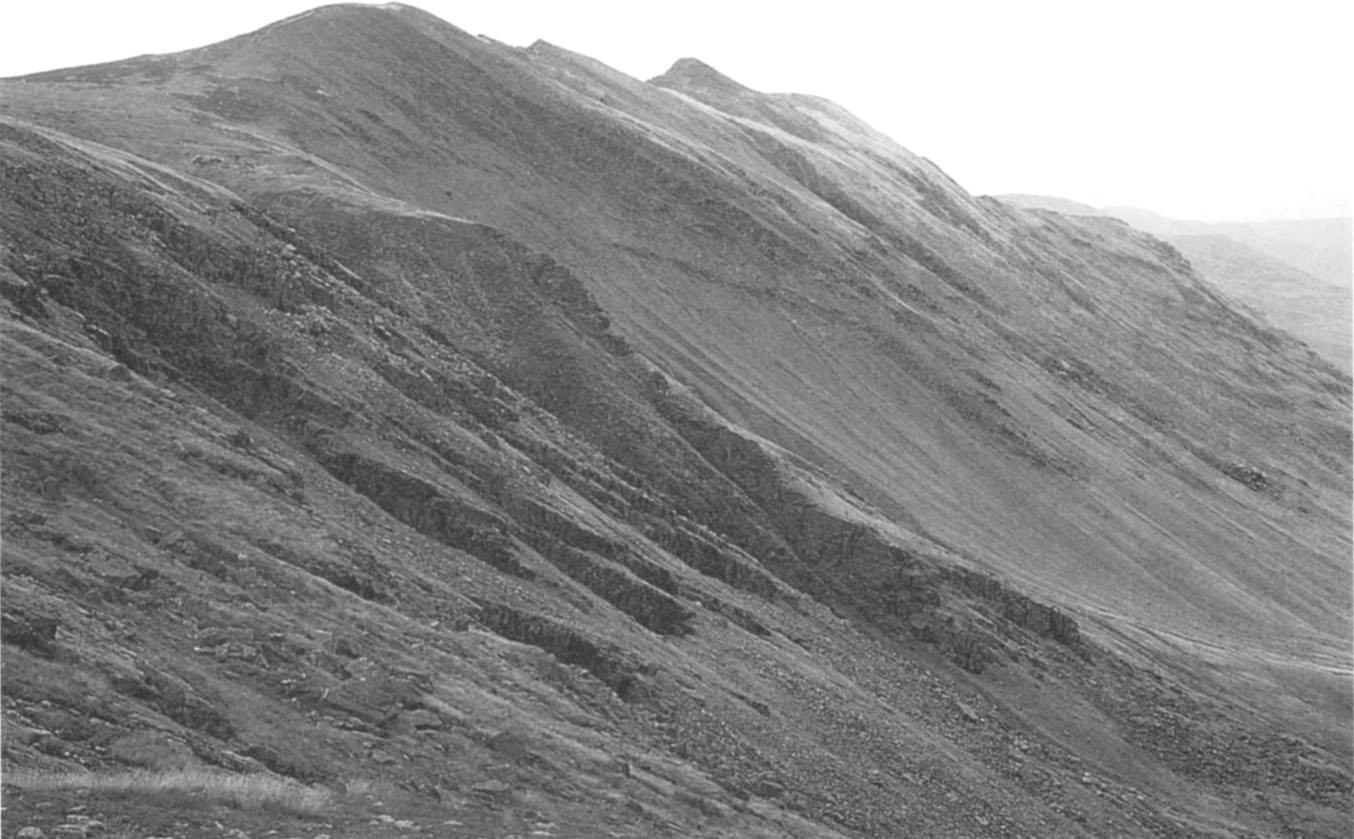
Mweelrea Mountain, Co. Mayo. The scree slopes support little vegetation.
Macgillycuddy’s Reeks and Brandon Mountain, Co. Kerry
The Macgillycuddy’s Reeks in Kerry reach 1,039 m at their highest point and are made up of a number of other summits above 900 m. Despite their promising aspect, these mountains are botanically a disappointment. The arctic-alpine and alpine species recorded by Praeger above 914 m included alpine scurvygrass, roseroot, starry saxifrage, mountain sorrel, dwarf willow, stiff sedge, alpine hair-grass, green spleenwort and alpine clubmoss. The hoary whitlowgrass, another arctic-alpine, can be found lower down but the best places to encounter the arctic-alpine and alpine species are the cliffs south of Lough Eagher at the head of Cumloughra Glen, and the series of coombs – steep cliffs with boulder scree – north of Lough Gouragh. The Kerry speciality, the strawberry-tree, is found at an altitude of 160 m, while the delicate Tunbridge filmy-fern and Killarney fern make it to 600 m and 460 m respectively.22
Northwest of the Macgillycuddy’s Reeks, the Dingle peninsula sticks out into the Atlantic like a long, ridged finger built of sandstones and slates with its more geologically complex northwestern tip fringed with dramatic sea cliffs. The highest point there is Mount Brandon (952 m). Falling away from the eastern side of the summit the cliffs drop into a series of lakes, sometimes called paternoster lakes – they are strung out like rosary beads – each one lower than the previous one. Growing near the highest lake, at 715 m, are alternate water-milfoil and quillwort, at their most elevated stations known in Ireland. Praeger, writing in the Botanist in Ireland, reckoned that these cliffs were a repository of interesting species: ‘the richest alpine ground in the country’. Expeditions by Curtis between 1988 and 1990 in search of alpine bistort have brought renewed evidence of their richness.23 The Mount Brandon range, located in one of the remotest areas of Ireland and set in stunning scenery, would certainly repay more intensive investigations by botanists.
The arctic-alpines recorded, apart from the bistort, include alpine lady’s-mantle (found only here, at one other site in south Kerry and near Lough Ouler, Co. Wicklow), alpine meadow-grass (also only here and in the Benbulbin mountain range, Co. Sligo), alpine meadow-rue, alpine saw-wort, dwarf willow, yellow saxifrage, purple saxifrage, starry saxifrage, mountain sorrel and the alpine species, holly fern. The holly fern, like two other ferns present – the parsley fern and green spleenwort – is one of the true mountain ferns, and is usually found growing in crevices of base-rich rocks. The victim of unscrupulous plant collectors in the past, it is restricted to western Ireland where it has been recorded from seven sites, the most easterly being in Co. Fermanagh.16
Caha Mountains, Counties Cork and Kerry
The Caha Mountains, made up of a great ridge of Old Red Sandstone, lie some 40 km southwest of Macgillycuddy’s Reeks. The northern side presides over the majestic Kenmare Bay while to the south they slope down to Ban try Bay. The Cork–Kerry border runs through the high ridge, Hungry Hill being the highest point at 685 m. The interest of Caha rests with a most exciting discovery, made in July 1964, of the small and delicate recurved sandwort found growing in narrow cracks of bare outcrops of Old Red Sandstone slabs east of Knockowen (658 m) and to the north-northeast of Cushnaficulla summit (594 m).24 About 1,000 plants were found at each of the locations. The Caha Mountains are the only known station in Ireland for this sandwort and it has never been recorded in Britain. The plant is a short and small tufted perennial with prostrate to semi-erect woody stems, forming a compact cushion of leaves. It is distinguished from the somewhat similar spring sandwort, also found on mountains (locally in Clare, Antrim, Derry and on the Aran Islands, Co. Galway) by having mostly down-curved leaves and 5–7 veins on the white sepals. Its white flowers, which seem large in relation to the overall plant size, bloom from June to August.
How is it that recurved sandwort only occurs on the Caha Mountains and nowhere else in Ireland or Britain? The nearest recorded station is in the Serra de Gerez in Portugal from where it extends through the Pyrenees and Alps and further eastwards, in suitable siliceous mountain ranges, to the Romanian Carpathians.7 Geological evidence – no signs of glacial smoothing on the stone slabs: their present surface corresponds exactly to the bedding plane of the sandstone and knowledge of known movements of the ice sheets in the area – shows that the summits of both Knockowen and Cushnaficulla were spared the rigours of the ice sheets and overlooked the glaciers moving around below. Clearly the peaks were ice fee and could have acted as refugia for the sandwort during the last and earlier glaciations.25,26 Webb was of the opinion that the recurved sandwort was present in Ireland long before the last glaciation.7
While the recurved sandwort does not fall into the category as one of the 16 arctic-alpine species in Ireland, it is the only true ‘alpine’ species in the country according to the criteria of Webb as laid out earlier in this chapter. The presence of this sandwort on the Caha Mountains strengthens the argument that many species of the Irish flora are not recent immigrants but members of a more ancient flora that was able to survive in glacier-free areas during the Ice Age.
Benbulbin mountain range, Co. Sligo
These mountains are part of a Carboniferous limestone plateau that has survived the gradual down-wearing of the surrounding landscape over millions of years. The whole area, reaching 450–600 m in height, extends over about 500 km2 between Lough Gill in Co. Sligo and Lough Melvin in Co. Leitrim. There is no evidence from glacial deposits or markings by moving ice sheets to suggest that the mountains were covered by ice during the main phase of the Midlandian cold stage to the end of the Drumlin phase of the Midlandian cold stage (79,000–13,000 years ago), so they would have been available as refugia for flora and fauna when the ice sheets tore up and scoured the lower ground, destroying all forms of life.
Evidence that some of the existing Benbulbin mountain flora thrived at lower levels many thousands of years ago comes from plant materials identified from interstadial deposits of mud and moss peat uncovered beneath a drumlin at Derryvree, Co. Fermanagh, and from silt, exposed below glacial till by a river slicing through a drumlin at Hollymount, near Lisnaskea, Co. Fermanagh. They date from before 30,000 and 40,000 years ago respectively. Analysis of the plant materials indicate that the vegetation of the time was characteristic of a cold climate in a tundra landscape. The species identified included the following arctic-alpine and alpine plants: dwarf willow, mountain sorrel, fringed sandwort, purple saxifrage and mountain avens.27 Today the cliffs and screes of Benbulbin and surrounding mountains are one of the most important habitats for these species in Ireland, and include the only known site for the fringed sandwort. It is highly likely that in the face of approaching ice sheets these and other species moved up the mountain to take refuge from the advancing ice glaciers. Whether they survived the long period of polar desert conditions, with intense cold, is less certain.




